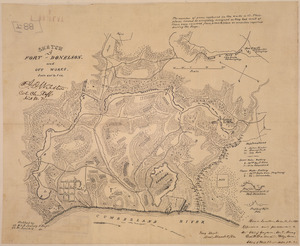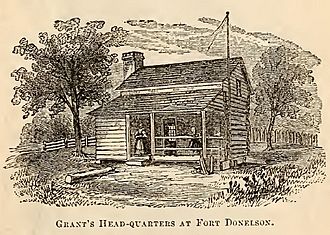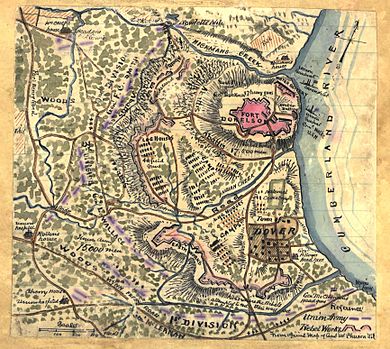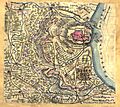Fort Donelson facts for kids
Quick facts for kids Fort Donelson |
|
|---|---|
| Tennessee (near Dover, Tennessee) | |
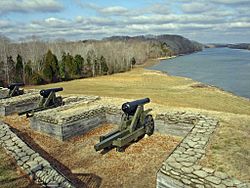
Part of the lower river battery at Fort Donelson, overlooking the Cumberland River
|
|
| Type | Fort |
| Site information | |
| Controlled by | |
| Site history | |
| Built | 1862 |
| In use | 1862–1865 |
| Materials | earth |
| Battles/wars | American Civil War |
Fort Donelson was an important fortress built in early 1862. It was created by the Confederacy during the American Civil War. Its main job was to control the Cumberland River. This river was a key pathway into the heart of Tennessee and the Confederacy. The fort was named after Confederate general Daniel S. Donelson.
The Union Army of the Tennessee, led by Major General Ulysses S. Grant, captured the fort in February 1862. They took it from the Confederate Army during the Battle of Fort Donelson. This was a huge win for the Union. It was part of Grant's plan to gain control of the Mississippi River. Union forces stayed at the fort for the rest of the war. A small group of Confederate soldiers tried to get it back in 1863, but they failed.
Contents
Building Fort Donelson
Bushrod Johnson from the Confederate Corps of Engineers chose the spot for Fort Donelson. He also watched over its building, which finished in early 1862. The fort was placed on a bend on the west side of the Cumberland River. It was meant to help Fort Henry. Fort Henry was on the Tennessee River, about 10 miles to the west.
To the north of Fort Donelson was Hickman River. This was a channel that was hard to cross without a boat. To the east, a small stream called Indian Creek flowed into the Cumberland. The fort itself had log huts for soldiers. It also protected the big guns that faced the river.
Like Fort Henry, Fort Donelson was not strong enough to stop a very large attack. But officers wanted to hold it for as long as possible. Engineers started making the defenses better. They dug trenches for soldiers along a ridge. They also built walls of earth in a three-mile arc. This arc surrounded the bluff to the north and the town of Dover to the south. Dover was where their main supplies were kept. Big cannons were placed on top of the hundred-foot bluff. These included a 128-pounder and two 32-pounders. Many workers from the nearby Cumberland Iron Works helped build the fort.
Confederate Leaders at Fort Donelson
Confederate troops held Fort Donelson until 1862. Here are some of the main leaders:
- Bushrod Johnson (February 9, 1862)
- Gideon J. Pillow (February 10–13, 1862)
- John B. Floyd (February 14–16, 1862)
- Simon B. Buckner, Sr. (February 16, 1862)
- Major Rice E. Graves, Jr., who led the artillery.
The fort was captured by Union General Ulysses S. Grant and his army. This happened during a winter attack to control the Mississippi River. Grant believed that controlling the river would split the Confederacy in two. You can learn more about this in the Battle of Fort Donelson article.
On August 25, 1863, a group of Confederate soldiers attacked the fort again. They demanded that the Union troops give up. But their attack failed, and the Union soldiers pushed them back.
The Union Attack
General U.S. Grant and Flag Officer Andrew Foote led the attack on Fort Donelson. They surrounded the fort and captured it after a short siege. On February 6, Grant was told by General Henry Halleck to attack Fort Donelson right away. He was supposed to capture it by February 8. Grant looked at the area and saw the fort's defenses. He knew it would not be taken by the 8th.
He got his generals ready for a land attack. These included Brigadier Generals John A. McClernand, Charles F. Smith, and Lew Wallace. At the same time, Flag Officer Foote moved his gunboats to attack from the river. After some small fights on the way, the main attack on Fort Donelson began on February 12.
On February 14, a naval battle took place. Union ships were badly damaged during this fight. The Confederates tried to escape on February 15 using roads to Nashville. But they could not get away. So, on February 16, the Confederates gave up. They surrendered Fort Donelson to the Union.
Fort Donelson Under Union Control
The Union was very happy when they heard Fort Donelson had surrendered. Union forces now controlled one of the biggest forts in the western part of the war. The war had not been going well for the Union in Virginia. But capturing Fort Henry and Fort Donelson were important victories.
After the main fighting moved away, Fort Donelson became less important. But Union troops still stayed there. Later, a Confederate force attacked the fort again. This group had 450 foot soldiers, 335 cavalry (soldiers on horseback), and two cannons. The Union soldiers defending the fort were 404 men from the 71st Ohio Regiment. The Confederates had 30 soldiers hurt. Then they left. The Fifth Iowa Cavalry chased them, but could not catch them.
Union Leaders at Fort Donelson
Here are some of the main Union leaders who were at Fort Donelson:
- Ulysses S. Grant (February 1862)
- Abner Harding (September 1862–1863)
- William W. Lowe (February 1863)
After the War
The Fort Donelson National Battlefield was created in 1928. This park was added to the National Register of Historic Places on October 15, 1966. It was renamed a national battlefield on August 16, 1985. Later, Fort Heiman was also added to the park.
Images for kids


